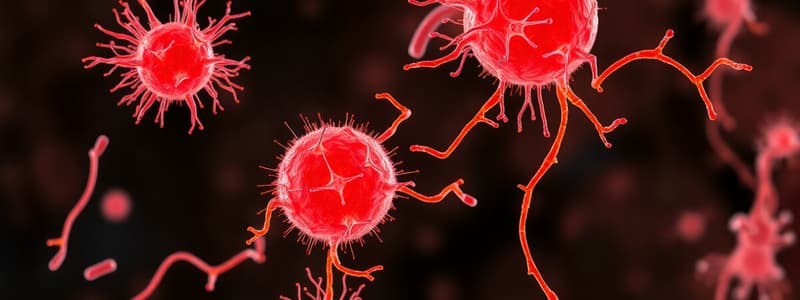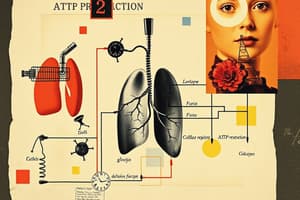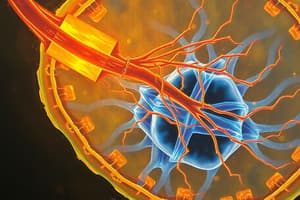Podcast
Questions and Answers
During strenuous exercise, muscle cells may switch to lactic acid fermentation. What is the primary purpose of this metabolic shift?
During strenuous exercise, muscle cells may switch to lactic acid fermentation. What is the primary purpose of this metabolic shift?
- To completely oxidize glucose into carbon dioxide and water anaerobically.
- To synthesize glycogen from excess glucose molecules.
- To produce a large amount of ATP quickly to meet energy demands, even more than aerobic respiration.
- To regenerate NAD+ so that glycolysis can continue to produce a small amount of ATP. (correct)
In eukaryotic cells, the electron transport chain (ETC) is located in the inner mitochondrial membrane. What is the immediate consequence of electrons passing through the ETC?
In eukaryotic cells, the electron transport chain (ETC) is located in the inner mitochondrial membrane. What is the immediate consequence of electrons passing through the ETC?
- Directly phosphorylating ADP to produce ATP.
- Releasing carbon dioxide as a byproduct.
- Generating a proton gradient across the inner mitochondrial membrane. (correct)
- Breaking down glucose into pyruvate.
Cyanobacteria are photosynthetic organisms that existed early in Earth's history. What key impact did their photosynthetic activity have on the Earth's atmosphere?
Cyanobacteria are photosynthetic organisms that existed early in Earth's history. What key impact did their photosynthetic activity have on the Earth's atmosphere?
- Increase in methane concentration, contributing to a warmer climate.
- Formation of the ozone layer, protecting the Earth from UV radiation.
- Depletion of carbon dioxide levels by converting it into organic compounds.
- Significant increase in atmospheric oxygen levels, leading to the evolution of aerobic organisms. (correct)
Which of the following is a crucial distinction between substrate-level phosphorylation and oxidative phosphorylation?
Which of the following is a crucial distinction between substrate-level phosphorylation and oxidative phosphorylation?
In the absence of oxygen, certain microorganisms can utilize alternative electron acceptors in anaerobic respiration. Which of the following substances can serve as a final electron acceptor in anaerobic respiration?
In the absence of oxygen, certain microorganisms can utilize alternative electron acceptors in anaerobic respiration. Which of the following substances can serve as a final electron acceptor in anaerobic respiration?
During photosynthesis, the light-dependent reactions and the Calvin cycle are interconnected. What is the primary role of the light-dependent reactions in this process?
During photosynthesis, the light-dependent reactions and the Calvin cycle are interconnected. What is the primary role of the light-dependent reactions in this process?
Yogurt production relies on microbial fermentation. What is the main purpose of lactic acid fermentation in the yogurt-making process?
Yogurt production relies on microbial fermentation. What is the main purpose of lactic acid fermentation in the yogurt-making process?
Consider a scenario where a cell is undergoing cellular respiration. If the supply of oxygen suddenly becomes limited, what immediate effect will this have on the electron transport chain (ETC)?
Consider a scenario where a cell is undergoing cellular respiration. If the supply of oxygen suddenly becomes limited, what immediate effect will this have on the electron transport chain (ETC)?
In metabolic pathways, catabolic and anabolic processes are often coupled. What is the fundamental relationship between these two types of pathways?
In metabolic pathways, catabolic and anabolic processes are often coupled. What is the fundamental relationship between these two types of pathways?
During glycolysis, glucose is broken down into two molecules of pyruvate. Under what conditions will pyruvate be converted to acetyl-CoA to enter the Krebs cycle?
During glycolysis, glucose is broken down into two molecules of pyruvate. Under what conditions will pyruvate be converted to acetyl-CoA to enter the Krebs cycle?
Which of the following best describes the role of NADH and FADH2 in cellular respiration?
Which of the following best describes the role of NADH and FADH2 in cellular respiration?
Consider a plant cell exposed to prolonged darkness. How will this affect the Calvin cycle?
Consider a plant cell exposed to prolonged darkness. How will this affect the Calvin cycle?
Ethanol fermentation by yeast is used in the production of alcoholic beverages. What is the primary purpose of converting pyruvate to ethanol in this process?
Ethanol fermentation by yeast is used in the production of alcoholic beverages. What is the primary purpose of converting pyruvate to ethanol in this process?
During photosynthesis, where does the oxygen that is released come from?
During photosynthesis, where does the oxygen that is released come from?
How does the location of the Krebs cycle differ between prokaryotic and eukaryotic cells?
How does the location of the Krebs cycle differ between prokaryotic and eukaryotic cells?
Which of the following is an anabolic pathway?
Which of the following is an anabolic pathway?
What is the role of chlorophyll in photosynthesis?
What is the role of chlorophyll in photosynthesis?
Which process regenerates NAD+ during anaerobic conditions, allowing glycolysis to continue?
Which process regenerates NAD+ during anaerobic conditions, allowing glycolysis to continue?
Which of the following statements correctly describes the amount of ATP produced by aerobic respiration compared to anaerobic respiration?
Which of the following statements correctly describes the amount of ATP produced by aerobic respiration compared to anaerobic respiration?
Which of the following is the correct balanced equation of aerobic respiration?
Which of the following is the correct balanced equation of aerobic respiration?
Flashcards
Cellular Respiration
Cellular Respiration
Metabolic process that converts biochemical energy from nutrients into ATP.
Glycolysis
Glycolysis
Initial stage of cellular respiration, breaking down glucose into pyruvate.
Krebs Cycle
Krebs Cycle
Cycle oxidizing acetyl-CoA, releasing CO2, ATP, NADH, and FADH2.
Electron Transport Chain (ETC)
Electron Transport Chain (ETC)
Signup and view all the flashcards
Substrate-Level Phosphorylation
Substrate-Level Phosphorylation
Signup and view all the flashcards
Oxidative Phosphorylation
Oxidative Phosphorylation
Signup and view all the flashcards
Anaerobic Process
Anaerobic Process
Signup and view all the flashcards
Aerobic Process
Aerobic Process
Signup and view all the flashcards
Fermentation
Fermentation
Signup and view all the flashcards
Lactic Acid Fermentation
Lactic Acid Fermentation
Signup and view all the flashcards
Ethanol Fermentation
Ethanol Fermentation
Signup and view all the flashcards
Photosynthesis
Photosynthesis
Signup and view all the flashcards
Light-Dependent Reactions
Light-Dependent Reactions
Signup and view all the flashcards
Light-Independent Reactions (Calvin Cycle)
Light-Independent Reactions (Calvin Cycle)
Signup and view all the flashcards
Photosynthetic Organisms
Photosynthetic Organisms
Signup and view all the flashcards
Metabolic Pathways
Metabolic Pathways
Signup and view all the flashcards
Catabolic Pathways
Catabolic Pathways
Signup and view all the flashcards
Anabolic Pathways
Anabolic Pathways
Signup and view all the flashcards
Study Notes
- Microbiology encompasses the study of microorganisms, including bacteria, archaea, fungi, protists, and viruses.
- These organisms are central to various biological processes, including cellular respiration, fermentation, and photosynthesis.
Cellular Respiration
- Cellular respiration is a metabolic process that converts biochemical energy from nutrients into adenosine triphosphate (ATP).
- ATP is the energy currency of the cell, providing power for various cellular activities.
- The process involves a series of metabolic pathways where glucose is oxidized to carbon dioxide and water.
- Aerobic respiration requires oxygen and yields a significantly higher amount of ATP compared to anaerobic processes.
- The general equation for aerobic respiration is: C6H12O6 + 6O2 → 6CO2 + 6H2O + energy (ATP).
Glycolysis
- Glycolysis is the initial stage of cellular respiration, occurring in the cytoplasm.
- It involves the breakdown of glucose into two molecules of pyruvate.
- Glycolysis produces a small amount of ATP and NADH (a reduced form of nicotinamide adenine dinucleotide).
- It does not require oxygen and can occur under both aerobic and anaerobic conditions.
Krebs Cycle (Citric Acid Cycle)
- The Krebs cycle takes place in the mitochondrial matrix in eukaryotes and the cytoplasm in prokaryotes.
- Pyruvate is converted into acetyl-CoA, which enters the cycle.
- The cycle oxidizes acetyl-CoA, releasing carbon dioxide and producing ATP, NADH, and FADH2 (flavin adenine dinucleotide).
Electron Transport Chain (ETC)
- The electron transport chain is located in the inner mitochondrial membrane in eukaryotes and the cytoplasmic membrane in prokaryotes.
- NADH and FADH2 donate electrons, which are passed through a series of protein complexes.
- This process generates a proton gradient across the membrane, which is used to synthesize ATP through oxidative phosphorylation.
- Oxygen acts as the final electron acceptor, forming water.
ATP Production
- ATP is produced through substrate-level phosphorylation and oxidative phosphorylation.
- Substrate-level phosphorylation involves the direct transfer of a phosphate group from a substrate molecule to ADP.
- Oxidative phosphorylation uses the energy from the electron transport chain to create a proton gradient, driving ATP synthase to produce ATP.
- Aerobic respiration can generate approximately 32 ATP molecules per glucose molecule.
Anaerobic vs. Aerobic Processes
- Aerobic processes require oxygen, while anaerobic processes do not.
- Aerobic respiration yields significantly more ATP compared to anaerobic respiration or fermentation.
- Anaerobic respiration uses electron acceptors other than oxygen, such as sulfate or nitrate.
- Fermentation is an anaerobic process that regenerates NAD+ from NADH, allowing glycolysis to continue.
Fermentation
- Fermentation is a metabolic process that extracts energy from carbohydrates in the absence of oxygen.
- It is used by various microorganisms and in muscle cells during intense exercise when oxygen supply is limited.
- Fermentation regenerates NAD+ by passing electrons from NADH to an organic molecule.
- Common fermentation products include lactic acid and ethanol.
Microbial Fermentation Types
- Lactic acid fermentation involves the conversion of pyruvate to lactic acid.
- Ethanol fermentation converts pyruvate to ethanol and carbon dioxide.
- Various other fermentation types produce different organic acids, alcohols, and gases.
- Fermentation is used in the production of foods such as yogurt, cheese, beer, and wine.
Photosynthesis
- Photosynthesis is the process by which plants, algae, and some bacteria convert light energy into chemical energy.
- It uses carbon dioxide and water to produce glucose and oxygen.
- The general equation for photosynthesis is: 6CO2 + 6H2O + light energy → C6H12O6 + 6O2.
- Photosynthesis occurs in chloroplasts in eukaryotes and in the cytoplasm of photosynthetic bacteria.
Light-Dependent Reactions
- Light-dependent reactions occur in the thylakoid membranes of chloroplasts and involve the capture of light energy by chlorophyll.
- This energy is used to split water molecules, releasing oxygen, protons, and electrons.
- ATP and NADPH are produced during these reactions.
Light-Independent Reactions (Calvin Cycle)
- Light-independent reactions (Calvin cycle) occur in the stroma of chloroplasts.
- Carbon dioxide is fixed and converted into glucose using ATP and NADPH generated during the light-dependent reactions.
Photosynthetic Organisms
- Plants, algae, and cyanobacteria are the primary photosynthetic organisms.
- These organisms play a crucial role in the Earth's ecosystem by producing oxygen and converting carbon dioxide into organic compounds.
- Photosynthetic bacteria, such as cyanobacteria, were among the first organisms to perform oxygenic photosynthesis.
Metabolic Pathways
- Metabolic pathways are a series of interconnected biochemical reactions that convert specific molecules into other molecules.
- These pathways can be catabolic (breaking down molecules) or anabolic (building molecules).
- Cellular respiration, fermentation, and photosynthesis involve multiple interconnected metabolic pathways.
Catabolic Pathways
- Catabolic pathways break down complex molecules into simpler ones, releasing energy (e.g., cellular respiration).
- These pathways often involve the oxidation of molecules, releasing electrons that are captured by electron carriers such as NADH and FADH2.
Anabolic Pathways
- Anabolic pathways use energy to build complex molecules from simpler ones (e.g., photosynthesis).
- These pathways often involve the reduction of molecules, requiring electrons from electron carriers such as NADPH.
Studying That Suits You
Use AI to generate personalized quizzes and flashcards to suit your learning preferences.




